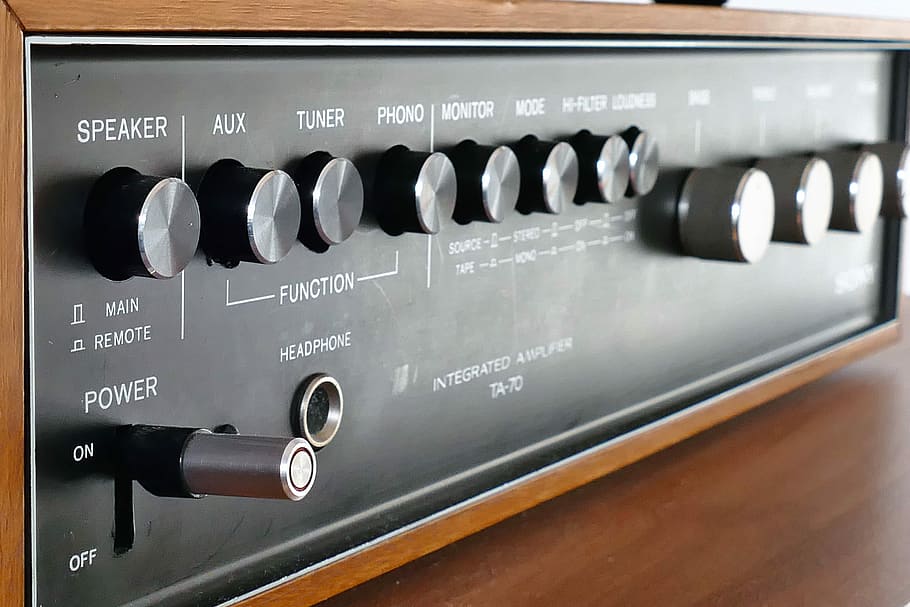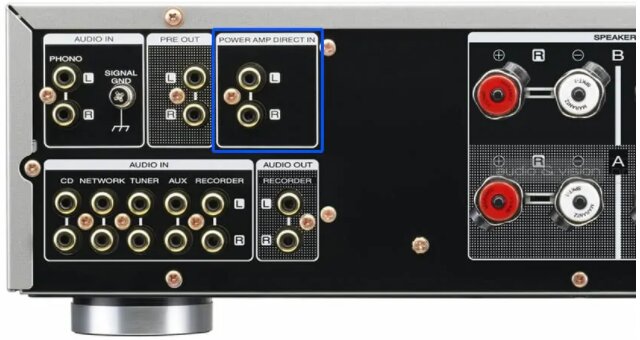
Perhaps you just want to use your integrated amp as a power amp, or maybe you prefer how an external preamp sounds. Whatever the reason, being able to use a preamp with an integrated amp is something many audiophiles and audio engineers would love to know. But is it possible? Can a preamp be used with an integrated amp?
Short answer, Yes. A preamp can be used with an integrated amp. Ideally, you must connect the preamp’s output to the Main Input of the integrated amp. This will bypass the integrated amp’s built-in preamp. Alternatively, you can use the Aux Input if the built-in preamp is passive.
This is an excellent and valid question, and you will know why in a moment. Later in this article, we’ll talk about the possible problems with using a preamp with an integrated, and then we’ll take a look at the best ways to connect a preamp to an integrated amp.
Table of Contents
Now let’s talk about why it’s a good idea to use an external preamp with an integrated preamp.
Reasons to Use a Preamp with an Integrated Amp
Here are two reasons why you should use an external preamp with an integrated amp.
1. Better Sound Quality
As you may already know, an integrated amplifier is a device that has both a preamplifier and a power amplifier built into it. This means any audio signal that passes through an integrated amp goes through two stages of amplification.
First is the preamplification stage, which converts a weak signal to a line-level signal for further processing. And then, the power amplification stage that further boosts the line level signal from the preamp to a speaker-level signal to drive through loudspeakers.
Integrated amplifiers work as they should. However, manufacturers compromise a lot when it comes to the sound quality of an integrated amp. To make integrated amps cost-effective, they don’t put much effort into making a great sounding built-in preamp and power amp.
Most preamps inside integrated amps do not match up to the quality of standalone preamps. Even high-end integrated amps still make some compromises when it comes to the sound quality of their built-in preamps.
There are other factors that also affect the sound quality of integrated amps. For instance, the same power supply is shared between the built-in preamp and the power amp of an integrated amp. That may directly or indirectly affect the performance and, in effect, the sound quality of the integrated amp.
For these reasons, it’s a good idea to use an external preamp to boost an audio signal and then send that through the power amp section of the integrated amp. The audio will sound much better as compared to running the signal through the internal preamp in the integrated amp.
2. To Use Preamp’s Features
There are a handful of preamps available today with unique features. Besides the typical gain control knob that you will find on nearly every preamp, there are some preamps with equalizers, a reverse polarity feature, or even some audio effects such as reverb, compressor, or an overdrive.
One popular and sought after preamp with extra features is the dbx 286s 2-Way Stereo Preamp(on Amazon). It comes with a DeEsser, Compressor, Enhancer, and an Expander, all built into one compact box.
If you own a high-end preamp with these features and you want to make use of them, it’s a good idea to hook it up to your integrated amp. This will allow you to sculpt your output sound the way you want it.
Problems with Using a Preamp with an Integrated Amp
There is the right and wrong way to use a preamp with an integrated amp. If you connect these two devices the wrong way, there are underlying problems that may occur. What do I mean by this?
When you connect a preamp to an integrated amp the wrong way, you will essentially be running your audio signal through two preamps and a power amp. I discussed, in detail, the problems with using two preamps in a previous article, and I recommend you check it out.
However, here are some problems with using a preamp with an integrated amp.
1. Increased noise floor
Noise floor refers to the undesired background noise in an audio signal. Most of the time, the audio source being fed into a preamp will have some noise. The noise could be from the environment, captured through a microphone, from a nearby HVAC system, or from undesired reflections in the room.
Most preamps also contribute to the noise floor when amplifying a signal. The standard noise added by a preamp is between 3 to 6dB loud. However, a few ultra-low noise preamps are available today, which will contribute less than 1dB of noise to a signal after preamplification.
So, essentially, running an audio signal through two preamps will increase the noise floor even more.
Firstly, the noise in the audio signal itself will be preamplified by the first preamp, and then an additional 3-6dB of noise will be added to the first preamp’s output. The first preamp’s output will then be fed to the second preamp, further amplifying the noise from the first preamp and adding another 3-6dB of noise.
After the two preamplification stages, the signal will then be sent to the power amp for further processing. By the end of all three stages, the noise floor will be very high at that point. At the end of the day, you will have a noisy audio signal coming out of the loudspeakers.
You certainly don’t want a noisy audio signal. However, that’s what happens when you run an audio signal through a preamp and the built-in preamp of an integrated amp.
Signal Distortion
Running an audio signal through a preamp and an integrated amp can also cause signal distortion if you don’t do it right.
That’s because running an audio signal through two stages of preamplification will boost the signal too high; it will surpass the maximum allowable headroom of your amp. Once it surpasses the limit, the signal will begin to clip from that point.
However, this problem can be managed when you set gain levels on both preamps properly. I’ll talk more about that later.
Ways to Connect a Preamp with an Integrated Amp
Here are the different ways to connect a preamp with an integrated. I’ll order it from the best method to the least preferred way. The way to go will ultimately depend on the type of integrated amp you own. Let’s get into it.
1. Use Main Input
The best way to connect a preamp is to use the Main Input on the integrated amp. On some integrated amps, this is labeled as Main Ins, Direct Input, Power Amp Direct Ins, or Home Theater Bypass.
Simply connect the preamp’s output to the main input on your integrated amp with an audio cable. But why should you use the main input?
The main input or direct input bypasses the integrated amp’s built-in preamp and directly sends the signal to the power amp. By connecting the preamp to the main in, you avoid the issue of increased noise floor and signal distortion. That’s because you’ll be using a single preamp instead of two.

Back in the day, the built-in preamp of integrated amps had an audio output that was connected to the Main Ins with a Jumper cable. If you own one of those integrated amps, you are in luck. Simply plug out the Jumper Cable from the Main Ins and plug your external preamp’s output into the Main Input with an audio cable, mostly an RCA stereo cable.
Nowadays, the preamp and power amp of integrated amps are connected internally. However, some high end integrated amps still have Main Ins at the back of the unit that bypasses the built-in preamps.

A perfect example of a high-end integrated amplifier with Direct Input is the Marantz PM8006 Integrated Amp (on Amazon). If you already own an expensive integrated preamp, chances are that it has a direct input that bypasses the built-in preamp.
2. Use Aux Input
If your integrated amp’s built-in preamp is passive, you can simply plug in your external preamp’s output into the integrated amp’s Aux Input.
But what is a passive preamplifier? A passive preamplifier does not boost the gain of an audio signal passing through it. It only either increases or decreases the volume of the signal passing through it. If you didn’t know, gain and volume are two totally different things.
I wish I could explain the difference between the two, but that’s not the point of this article. If you want to know the difference between the two, read this article on Musicians on a Mission. Simply put, a passive preamp in an integrated amp is volume control.
To find out if your integrated amp’s built-in preamp is passive, I recommend you read the manual. If you still have the hard copy, great. Else, you can check it online.
If the built-in preamp is active, you can still use the Aux Input. However, keep in mind, your signal is going through two stages of preamplification. To prevent issues such as increased noise floor and signal distortion, I recommend turning down the gain on the integrated amp’s internal preamp.
Conclusion
In summary, a preamp can be used with an integrated amplifier. Most high-end integrated amp manufacturers include Main Input or Direct Input port that, when used, bypasses the integrated amp’s built-in preamp. It’s the best way to use an external preamp with an integrated amp.
However, if there is no Main Input on your integrated amp, you can use the Aux Input on your integrated amp.

Hi, I’m Raymond. A keyboard player, music producer, and writer. And I’m also the founder of this blog. As someone who has been working with several audio and music equipment and different musicians for many years, my goal is to answer all your questions on music and equipment, as well as the latest music software and technology. For more info, check out my about me page
